
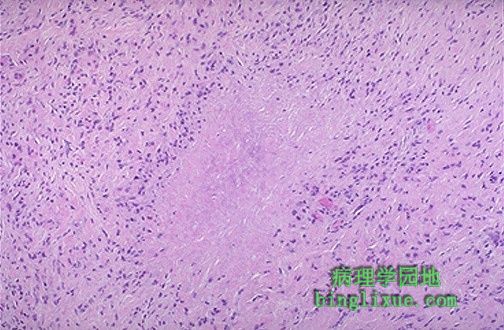 |
类风湿结节,见于严重的类风湿关节炎,出现于骨隆凸上的皮下如肘之上,偶见于内脏器官。结节中央为纤维素样坏死物,四周围绕着上皮样细胞与其它单核细胞。 Here is a rheumatoid nodule. Such nodules are seen in patients with severe rheumatoid arthritis and appear beneath the skin over bony prominences such as the elbow. They can occasionally appear in visceral organs. There is a central area of fibrinoid necrosis surrounded by pallisading epithelioid macrophages and other mononuclear cells. |
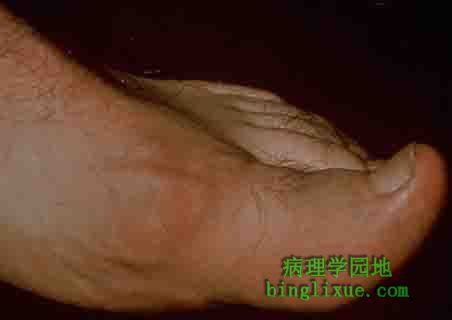 |
痛风病人痛风性关节炎是由关节处尿酸盐结晶沉积引起。如图所见的第一MP关节(大趾),它是最常受影响的关节。急性发作是以剧痛、肿胀与关节红斑为特征。 This is gout. Gouty arthritis results from deposition of sodium urate crystals in joints. The joint most often affected is the first MP joint (big toe) as seen here. Acute attacks are characterized by severe pain, swelling, and erythema of the joint. |
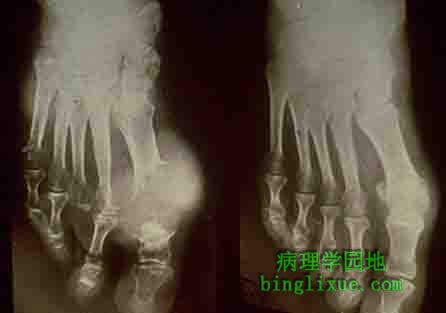 |
慢性痛风导致尿酸盐沉积为似白垩的物质,即痛风石。这种痛风石会破坏关节及相邻的骨,图示的两张X线片均为病人右足(只不过做了两次X线拍摄),大多数但非所有情况会有高尿酸血症。 Chronic gout leads to deposion of urates into a chalky mass known as a "tophus". Such tophi can destroy the joint and adjacent bone as seen here radiographically in sequential radiographs of the same foot (the patient did not have two right feet). In most, but not all, cases there is hyperuricemia. |
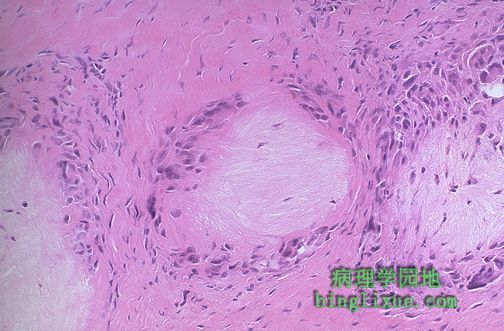 |
灰白区域是痛风石或由淋巴细胞、巨噬细胞、异物巨细胞浸润围绕的尿酸盐结晶的聚集物。痛风石是痛风的特征性病变,大多见于关节周围的软组织,包括肌腱与韧带,较少见于其它地方。沙粒状痛风是由急性痛风发作期尿酸钠盐结晶继续析出引起。 The pale areas seen here are tophi, or aggregates of urate crystals surrounded by infiltrates of lymphocytes, macrophages, and foreign body giant cells. A tophus is the characteristic finding of gout. Tophi are most likely to be found in soft tissues, including tendons and ligaments, around joints. Less commonly tophi appear elsewhere. Tophaceous gout results from continued precipitation of sodium urate crystals during attacks of acute gout. |
 |
痛风病人关节液检测可见尿酸盐结晶,如图示呈针状。如果用红光补偿棱镜在偏振光下观察,在补偿棱镜的主(“慢”)轴方向呈黄色(反双折射)而在相反的垂直方向呈蓝色。 If synovial fluid is aspirated from a patient with gout, the fluid can be examined for the presence of sodium urate crystals, which are seen here to be needle shaped. If they are observed under polarized light with a red compensator, they appear yellow (negatively birefringent) in the main ("slow") axis of the compensator and blue in the opposite perpendicular direction. |
 |
焦磷酸钙菱形结晶在红感光板偏振光下呈蓝白色(弱正双折射)。焦磷酸钙结晶沉积病(有时称为“假性痛风”)在50岁以上人群中并不少见,它能引起膝关节、腕关节、肘关节、肩关节与踝关节的急性、亚急性或慢性关节炎。这种关节病变是进行性的,但大多数人的这种病不严重。 This rhomboid shaped crystal of calcium pyrophosphate, which appears bluish-white (weak positive birefringence) by polarized light with red plate. Calcium pyrophosphage crystal deposition disease (sometimes called "pseudogout") is not uncommon in persons over the age of 50, and can lead to acute, subacute, or chronic arthritis of knees, wrists, elbows, shoulders, and ankles. The articular damage is progressive, though in most persons the disease is not severe. |
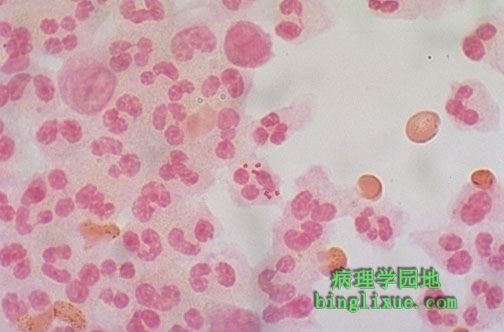 |
肿且有压痛的“热”关节可能提示急性化脓性关节炎。格兰氏染色显示许多嗜中性粒细胞,其中之一包含革兰阴性双球菌,提示淋病奈瑟菌感染。 A "hot" joint that is swollen and tender may indicate an acute suppurative arthritis. The gram stain shown here demonstrates many neutrophilic leukocytes, one of which contains gram negative intracellular diplococci indicative of Neisseria gonorrheae infection.
|